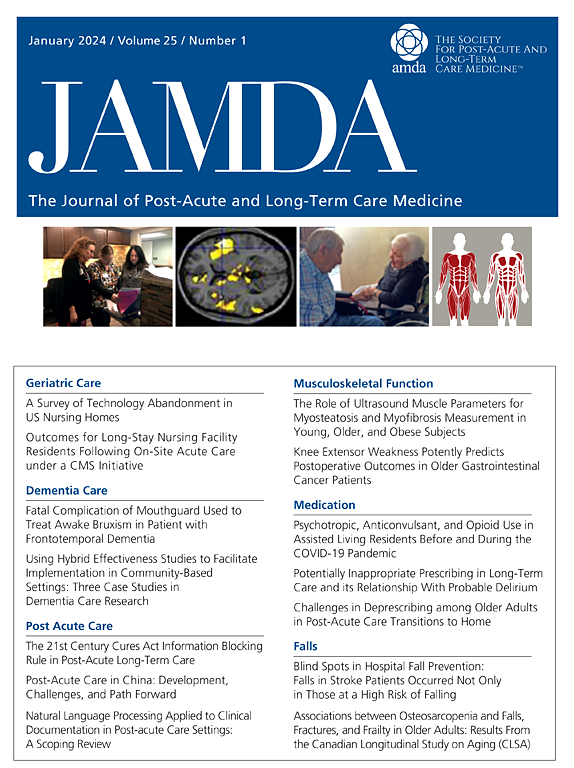口服抗凝剂的使用与长期护理院住户跌倒后的死亡率。
IF 4.2
2区 医学
Q2 GERIATRICS & GERONTOLOGY
Journal of the American Medical Directors Association
Pub Date : 2024-08-31
DOI:10.1016/j.jamda.2024.105233
引用次数: 0
摘要
目的:长期护理(LTC)住院患者很容易跌倒,如果同时使用抗凝药物,则可能会增加随后发病和死亡的风险。由于担心会出现大出血并发症,对于跌倒风险较高的居民来说,使用抗凝药的益处和害处存在不确定性。我们旨在研究使用抗凝剂是否会增加跌倒的 LTC 居民的死亡风险:设计:一项回顾性队列研究:2010年1月1日至2019年12月1日期间入住加拿大安大略省一家 LTC 机构的老年人(≥65 岁),他们因跌倒相关伤害而被转入急诊科:方法:暴露是指使用口服抗凝剂(OAC)。主要结果是转院后 30 天内的死亡率。次要结果是大出血和护理利用率。我们使用分层逻辑回归模型来研究使用 OAC 与 30 天死亡率之间的关系:共有 56419 名居民因跌倒而转院,其中 9611 人(17.0%)使用了 OAC。30 天后,5794 人(10.3%)死亡:12.0%(1151 人)使用了 OAC,9.90%(4643 人)未使用 OAC(风险差异 [RD],2.1%;95% CI,1.40%-2.82%)。大出血病例有 485 例:1.3%(125 例)使用 OAC,0.8%(360 例)未使用 OAC(RD,0.5%;95% CI,0.26%-0.74%)。多变量分析发现,使用 OAC 与 30 天死亡率无明显关联(几率比 [OR],0.98;95% CI,0.90-1.06),但大出血风险增加(OR,1.31;95% CI,1.04-1.66)。两组的医疗系统和神经外科护理使用情况相似:在因跌倒受伤而转入急诊科的长者护理中心居民中,OACs 不会增加跌倒后死亡的风险。为跌倒的体弱老年人开具 OAC 处方时应考虑到他们的个体风险情况。本文章由计算机程序翻译,如有差异,请以英文原文为准。
Oral Anticoagulant Use and Post-Fall Mortality in Long-Term Care Home Residents
Objectives
Long-term care (LTC) residents are susceptible to falling and the risk of subsequent morbidity and mortality may be compounded with concurrent anticoagulation use. Uncertainty exists around the benefit and harm of anticoagulation use for residents with a high risk for falls because of concerns of major bleeding complications. We aimed to examine if anticoagulant use increases mortality risk among LTC residents who fall.
Design
A retrospective cohort study.
Setting and Participants
Older adults (≥65 years) admitted to a LTC facility in Ontario, Canada between January 1, 2010, and December 1, 2019, who were transferred to emergency departments for fall-related injuries.
Methods
The exposure was the use of an oral anticoagulant (OAC). The primary outcome was mortality within 30 days of transfer. Secondary outcomes were major hemorrhage and care utilization. We used hierarchical logistic regression models to examine the association between the use of OAC and 30-day mortality.
Results
There were 56,419 residents transferred to the hospital for a fall, of whom 9611 (17.0%) were on an OAC. At 30 days, 5794 (10.3%) of the cohort had died: 12.0% (1151) on an OAC and 9.90% (4643) not on an OAC [risk difference (RD), 2.1%; 95% CI, 1.40%–2.82%]. There were 485 major hemorrhage cases: 1.3% (125) on an OAC and 0.8% (360) not on an OAC (RD, 0.5%; 95% CI, 0.26%–0.74%). Multivariable analysis found no significant association between OAC use and 30-day mortality [odds ratio (OR), 0.98; 95% CI, 0.90–1.06], but an increased risk of major hemorrhage (OR, 1.31; 95% CI, 1.04–1.66). Both groups had similar health system and neurosurgical care utilization.
Conclusions and Implications
Among LTC residents transferred to the emergency department for fall-related injuries, OACs did not increase the risk of post-fall mortality. OAC prescribing for frail older adults who experience falls should consider their individual risk profile.
求助全文
通过发布文献求助,成功后即可免费获取论文全文。
去求助
来源期刊
CiteScore
11.10
自引率
6.60%
发文量
472
审稿时长
44 days
期刊介绍:
JAMDA, the official journal of AMDA - The Society for Post-Acute and Long-Term Care Medicine, is a leading peer-reviewed publication that offers practical information and research geared towards healthcare professionals in the post-acute and long-term care fields. It is also a valuable resource for policy-makers, organizational leaders, educators, and advocates.
The journal provides essential information for various healthcare professionals such as medical directors, attending physicians, nurses, consultant pharmacists, geriatric psychiatrists, nurse practitioners, physician assistants, physical and occupational therapists, social workers, and others involved in providing, overseeing, and promoting quality

 求助内容:
求助内容: 应助结果提醒方式:
应助结果提醒方式:


